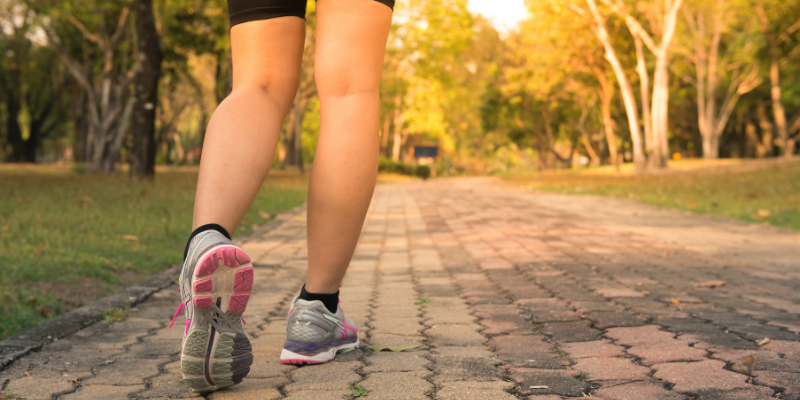In This Article
Why Brisk Walking is a Great Workout For You?
Brisk walking is one of the easiest yet effective cardio workouts to boost your physical and mental health. All you need is a pair of sneakers to get started. Let’s now read more about brisk walking benefits and what makes it an excellent workout for you. Brisk walking is a sweat-inducing workout that you can perform either indoors or outdoors without the need for any specialized equipment or training. It can quickly help you shed off those extra pounds from your body and beat stress at the same time. It is a low-impact activity that goes gentle on your body, but you must learn to maintain a pace that pumps up your lungs and heart. However, try not to go too hard on yourself as it may lead to exhaustion.
In This Article

What Is Brisk Walking?
The definition of brisk walking may vary from person to person. Some people consider walking a bit faster than your average pace to be brisk walking. However, this is partially correct.
There are three ways to measure your pace while brisk walking. Let us read about each one of them.
-
Number Of Steps Per Minute:
The easiest way to measure your walking pace is by counting the steps you take in a minute. You can use a fitness tracker for doing so. If you can cover at least 100 steps in a minute, it qualifies as brisk walking, and you can health the benefits of this physical activity.
-
Measure Heart Rate:
Another way to figure out whether you are walking fast enough or not is to measure your heart rate. For adults, the target heart rate while exercising must be around 60-85% of their maximum heart rate.
If you don’t know what your maximum heart rate is, you can calculate it as follows:
Maximum heart rate (in beats per minute) = Regular heart rate (220 beats per minute) – your age (in years)
For example, if your age is 30 years, your maximum heart rate will be 190 beats per minute (220 – 30 = 190 beats per minute).
You can check your pulse by placing your index and middle fingertips on the wrist. You can also use a fitness tracker to check your heart rate.
-
Speech Test:
It is another simple way to figure out your pace while walking. To apply the test, start talking while you are brisk walking. If you can talk properly with a bit of breathlessness, you are walking at a moderate pace. If you cannot speak properly and constantly run out of breath, you are walking too fast and may consider slowing down.
Now you know how to easily measure your walking pace by applying any of these methods. Go ahead and read about the gains of brisk walking regularly.
Must Read: Non-Surgical Weight Loss Treatment
Top 6 Brisk Walking Benefits
Like any other cardio exercise, brisk walking offers multiple physical and mental health benefits. Check out the below list:
-
Promotes Weight Loss:
Brisk walking can help you lose excess weight by burning calories. It also helps in increasing lean muscle mass and preventing obesity.
-
Improves Mental Health:
Some studies suggest that brisk walking can help improve brain function. It can also help reduce stress and enhance the quality of sleep.
-
Reduces The Risk of Diseases:
Brisk walking can reduce the risk of type 2 diabetes, stroke, and other lifestyle diseases related to obesity.
-
Lowers Blood Pressure:
Cardio activities, including brisk walking, effectively lower and maintain blood pressure.
-
Regulates Blood Sugar Level:
Brisk walking regularly can reduce blood sugar levels and increase insulin sensitivity in the body. Muscle cells can easily use insulin to convert glucose into energy.
-
Lowers Risk of Cardiovascular Complications:
It can also reduce the bad cholesterol (LDL) in your body and lower the risk of heart diseases.
Must Read: Is Running Good To Lose Weight And Burn Fat?
Tips To Do Brisk Walking Correctly
If you wish to maintain your weight, we suggest brisk walking at 3.5 mph or more for at least 150 minutes a week, i.e. at least 20 -30 minutes each day. It will help you burn about 140 calories every day, making a significant difference in your weight and overall fitness in the long run. To avoid injuries while brisk walking, here are a few techniques that you can follow:
- Stand straight and keep your chin up to look forward rather than downward.
- Now relax your body, especially your neck, back, and shoulder. However, avoid slouching at any cost.
- Roll your feet from heel to toe in a clockwise direction once and in an anti-clockwise direction once.
- Now swing your arms freely and start walking.Now, you know how to do brisk walking, yet it is advisable to consult a trainer to know the duration and pace you should practice based on your baseline weight and targeted weight loss, heart rate, health conditions, and more to improve your fitness score.
Must Read: What Is The Best Time To Exercise?
Takeaway
Brisk walking can benefit your health, even if it is done for 15-20 minutes a day. It helps reduce stress levels, keeps your mind at peace, and boosts blood flow in the body, which is beneficial for the functioning of your heart and lungs. However, if you have any injuries or health concerns, it is advisable to seek professional advice from experts before starting your walking regimen. Visit Oliva Skin & Hair Clinic to learn more about a customized health program today!
Frquently Asked Question On Why Brisk Walking is a Great Workout For You?
Brisk walking is very beneficial for your overall health. It promotes weight loss and boosts blood flow. Walking at a moderate pace also helps improve the brain’s functioning, thereby reducing stress levels and enhancing sleep quality.
Brisk walking provides the same benefits as any aerobic exercise. The best part is that you don’t need any special equipment or advanced training for this. This simple exercise can help regulate blood pressure, improve blood circulation, and reduce your anxiety and stress levels.
Walking helps in strengthening and tightening your calves, thighs, and glutes. It is an effective exercise to tone the midsection and lower limbs.
For an effective workout session, you must walk for 30 minutes a day and up to 5 times a week. It will help strengthen your bones and get rid of excess body fat. However, follow the advice of your trainer to achieve the best weight loss results.
Walking every day for an hour can help you lose weight and provide you with a host of health benefits. You must focus on the duration and pace of your walk as advised by your weight-loss expert to reach your fitness goals.
Our certified subject matter experts do extensive research and collate facts from reputed scientific journals and international studies to create informative and engaging articles related to all your dermatology concerns. They strive to help you decipher medical jargon, distinguish fact from fiction and overcome paranoia. Our qualified medical board or expert panel goes a step further to verify these facts based on their rich academic knowledge, vast clinical experience and critical industry insights to ensure you consume only medically accurate content that empowers you to make informed decisions about your hair and skin-care treatments and weight management. Check out our Editorial policy for further details
https://www.nhlbi.nih.gov/files/docs/guidelines/ob_gdlns.pdf
https://pubmed.ncbi.nlm.nih.gov/17413437/
https://pubmed.ncbi.nlm.nih.gov/28293594/
https://pubmed.ncbi.nlm.nih.gov/33661958/
https://www.ncbi.nlm.nih.gov/pmc/articles/PMC2991639/
https://www.ncbi.nlm.nih.gov/books/NBK384465/








